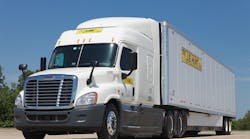Tax reform is proving beneficial to the bottom line of J.B. Hunt Transport Services, as it said its fourth quarter 2017 results now include a $309.2 million decrease in income taxes from deferred tax balances as a result of the Tax Cuts and Jobs Act enacted last year.
That helped the multi-modal carrier post net earnings of $385.3 million on $1.99 billion in operating revenue in the fourth quarter of 2017, or more than twice its net earnings of $117.6 million on $1.72 billion in operating revenue for the fourth quarter of 2016.
The company noted, however, that it took several charges against its fourth quarter 2017 earnings, too: a pre-tax charges of $20.3 million for a reserve on a cash advance for the purchase of new trailers from a manufacturer J.B. Hunt said “will not meet delivery” and $18.6 million for an increase in reserves for certain insurance and claims.
For 2017, J.B. Hunt said net earnings topped $686.6 million on total operating revenue of over $7.18 billion, which includes over $753.7 million in fuel surcharges, compared to net earnings of over $432 million on total operating revenues of over $6.55 billion (including $548.1 million in fuel surcharges) for 2016.
In terms of specific segments of freight demand, the company its intermodal division witnessed load growth of 5% and a 10% increase in segment revenue, while its Dedicated Contract Services (DCS) segment revenue increased by 20%, primarily from the addition of new customer accounts and improved asset utilization.
The carrier added that its Integrated Capacity Solutions (ICS) segment revenue increased by 40% primarily from a 19% increase in revenue per load and a 17% increase in load growth, while revenue within its truckload division (JBT) increased 1% primarily from customer rate per mile increases offset by a decrease in load count.
Other trends noted by J.B. Hunt in its earnings report:
- Operating income within its intermodal division decreased 25% compared to 2016 as benefits from increased volume and revenue per load were offset by increased costs to attract and retain drivers, higher third-party dray costs, increased insurance and claims costs and inefficiencies in the rail networks due to congestion and track and yard maintenance.
- Its DCS division added 1,326 revenue producing trucks in year-over-year comparisons between 2017 and 2016, with about 53% of those additions representing private fleet conversions and new contract implementations in this and prior periods. Customer retention rates remain above 98%.
- Yet DCS operating income decreased by 39% even though its revenues were up 20% due to higher driver wages – including the timing between wage increases and recovery through customer contracts – higher driver recruiting costs including the length of time to fill open positions, increased insurance and claims costs, plus higher equipment ownership costs compared to the same period in 2016.
- Within its ICS division, J.B. Hunt noted contractual volumes represent approximately 66% of the total load volume but only 46% of the total revenue in fourth quarter of 2017 compared to 75% and 62%, respectively, in fourth quarter of 2016. Yet operating income increased 86% over the same period in 2016, with gross profit margin increasing to 14.1% versus 12.9% last year primarily from the increased spot market activity which more than offset the margin compression realized in the contractual volumes.
- In its truckload segment, J.B. Hunt said that while revenue per load increased 13% primarily from a 12% increase in rates per loaded mile in the fourth quarter of 2017 when compared to equivalent lengths of haul in the fourth quarter 2016, those gains were offset by a 10% decrease in load count, higher driver wages and independent contractor costs, lower tractor utilization due to an increase in unseated trucks.



